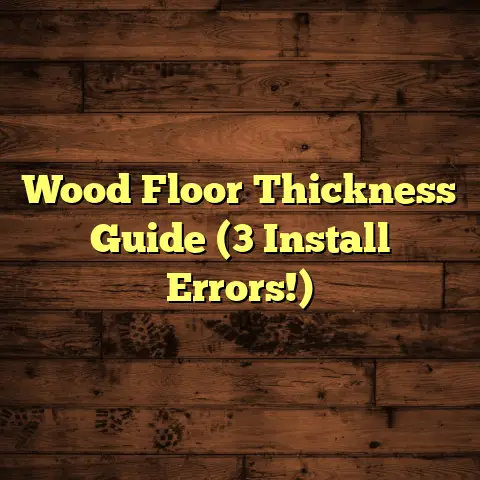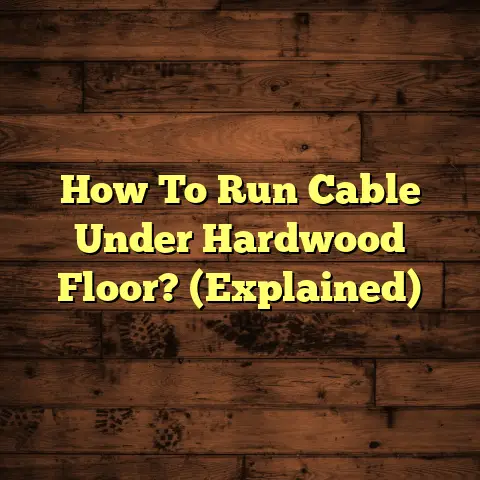Terrace Flooring Cost (Explained)
Terrace Flooring Cost (Explained)
When it comes to flooring options for your terrace, hardwood flooring is a popular choice due to its aesthetic appeal and durability. However, understanding the costs associated with hardwood installation is crucial for making informed decisions. This article provides a comprehensive overview of the factors influencing hardwood flooring costs, detailed cost breakdowns, comparisons with alternative flooring options, and essential maintenance tips.
Major Cost Factors Impacting Hardwood Flooring Installation
1. Area Size
The size of the area where you plan to install hardwood flooring significantly impacts the overall cost. Larger areas will require more materials and labor, increasing the total expense.
2. Hardwood Type
Different types of hardwood—such as oak, maple, cherry, and walnut—come with varying price points based on their availability and aesthetic qualities. Exotic woods may also be available at a higher cost.
3. Labor Costs
Hiring professionals for installation is often recommended, as proper installation is critical for longevity. Labor costs can vary based on location and the contractor’s experience.
4. Additional Considerations
- Floor Removal: If you need to remove existing flooring, this will add to your costs.
- Subfloor Replacement: Any necessary repairs or replacements of the subfloor should also be factored in.
- Material Grade: Higher-grade hardwoods (select and better) will typically cost more than lower grades (common).
- Room Size/Layout: Unusual room shapes or obstacles can increase labor time and costs.
- Installation Type: The method chosen (nail-down, glue-down, or floating) will affect both materials and labor costs.
Detailed Cost Breakdown
Cost Estimates by Area Size
| Area Size (sq. ft.) | Average Cost (Material + Labor) |
|---|---|
| 100 | $1,200 – $2,500 |
| 300 | $3,600 – $7,500 |
| 500 | $6,000 – $12,500 |
Cost Estimates by Hardwood Type
| Wood Type | Price per sq. ft. (Material Only) | Installation Cost (Estimated) |
|---|---|---|
| Oak | $3 – $8 | $2 – $5 |
| Maple | $4 – $9 | $2 – $5 |
| Cherry | $5 – $10 | $2 – $5 |
| Walnut | $6 – $12 | $2 – $5 |
| Engineered Wood | $3 – $7 | $2 – $5 |
Material Grades
- Common Grade: Generally ranges from $3 to $6 per sq. ft.
- Select Grade: Typically costs between $4 to $10 per sq. ft.
- Better Grade: Can range from $5 to upwards of $12 per sq. ft.
Comparison with Alternative Flooring Options
| Flooring Type | Average Cost per sq. ft. | Durability | Aesthetic Appeal | Maintenance |
|---|---|---|---|---|
| Hardwood | $5 – $12 | High | High | Moderate |
| Laminate | $1 – $4 | Moderate | Moderate | Low |
| Vinyl | $2 – $6 | High | Moderate | Low |
| Carpet | $1 – $5 | Low | High | High |
Signs That Hardwood Floors Need Replacement
- Severe Scratches and Gouges: If the surface is extensively damaged, refinishing may not suffice.
- Warping or Buckling: This indicates moisture damage and often requires replacement.
- Excessive Cupping: This can lead to further structural issues if not addressed.
- Outdated Style: If your flooring is outdated and no longer matches the home’s aesthetic, consider replacement.
Refinishing vs. Replacement
- Refinishing: Suitable for floors with minor scratches and stains; typically costs less than replacement.
- Replacement: Ideal for severely damaged or outdated flooring; involves a higher cost but offers a fresh start.
Pros and Cons of Hardwood Flooring
Pros
- Aesthetic Appeal: Adds warmth and value to any space.
- Durability: Can last for decades with proper care.
- Sustainable Option: If sourced responsibly, hardwood can be an eco-friendly choice.
Cons
- Cost: Higher initial investment compared to alternatives.
- Maintenance: Requires regular upkeep to prevent damage.
- Susceptible to Moisture: May not be suitable for all areas, particularly those prone to humidity.
Professional Installation vs. DIY
Cost Differences
- Professional Installation: Generally adds $2 to $5 per sq. ft. to material costs.
- DIY Installation: Saves on labor costs but requires tools and skills.
Tools Needed for DIY
- Miter saw
- Table saw
- Nail gun or flooring stapler
- Moisture meter
- Leveling tools
Importance of Proper Installation
Improper installation can lead to issues such as squeaks, gaps, and premature wear. Hiring professionals ensures that industry standards are met.
Questions to Ask Hardwood Flooring Contractors
- What types of wood do you recommend for my project?
- Can you provide references from past clients?
- What is included in your quoted price?
- How do you handle unexpected issues during installation?
- What warranties do you offer on materials and installation?
Hardwood Floor Care and Maintenance Tips
- Regular Cleaning: Sweep or vacuum regularly to remove debris.
- Moisture Control: Use mats in entryways and avoid excessive water exposure.
- Refinishing Schedule: Plan to refinish every 7-10 years, depending on wear.
- Protective Measures: Use felt pads under furniture legs to prevent scratches.
Conclusion
Understanding the costs associated with hardwood flooring installation will help you make informed decisions about your terrace project. From evaluating different types of wood and installation methods to weighing the pros and cons of professional versus DIY installations, this guide aims to equip you with the knowledge needed for a successful flooring project. With proper care and maintenance, your hardwood floors can enhance your space’s beauty and functionality for many years to come.





